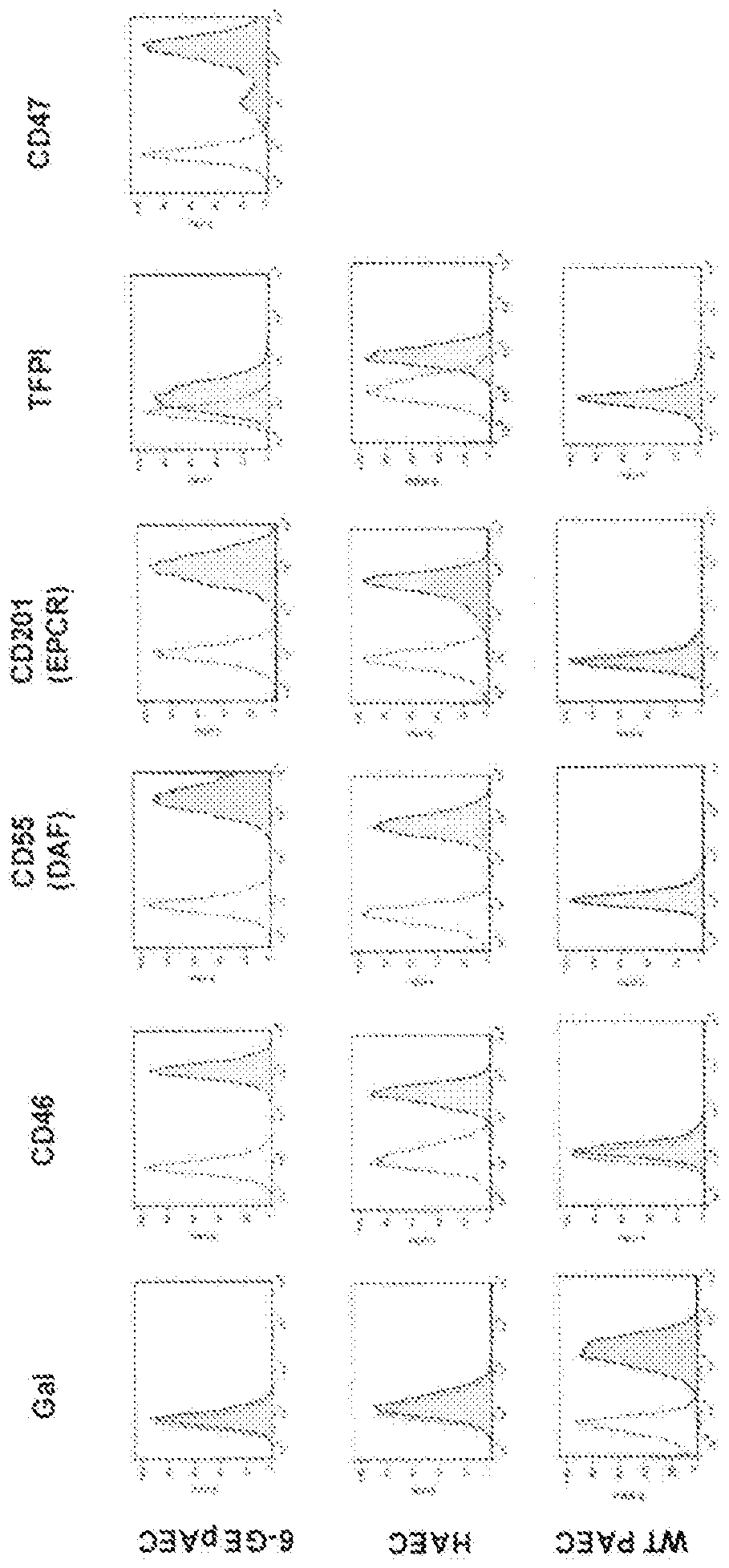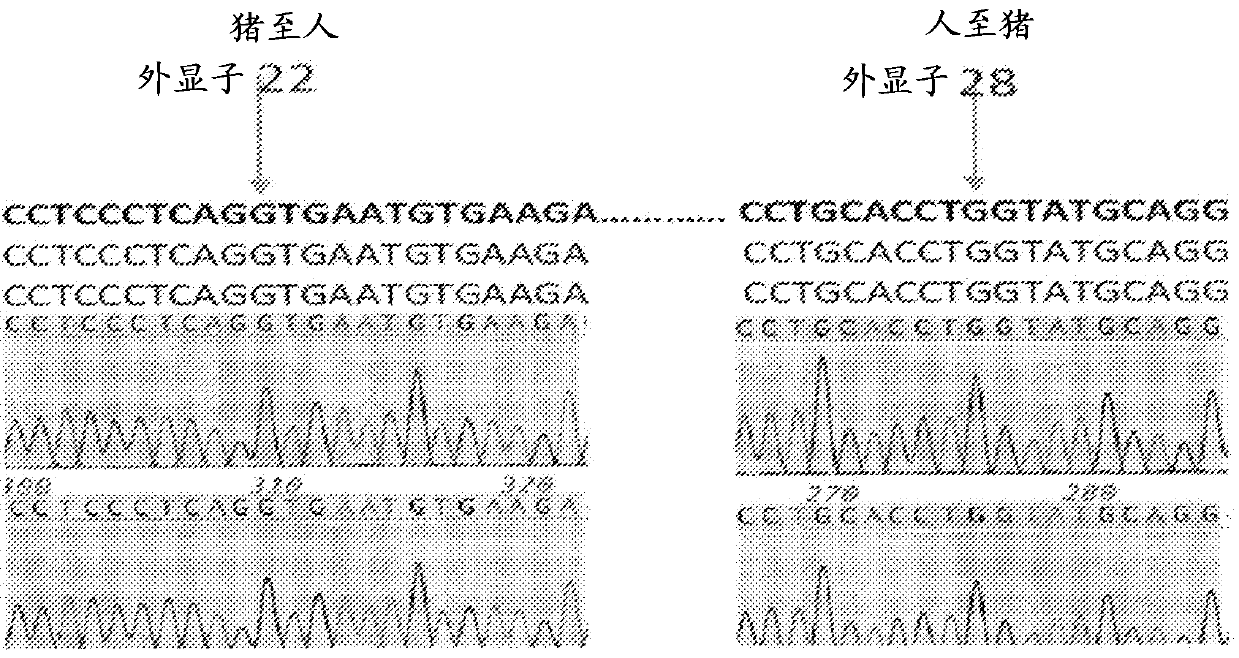Multi-transgenic pig for xenotransplantation
A transgenic pig and transgenic technology, applied in the field of preparation of the animal, therapeutic use, and transgenic pig, can solve the problems that multiple transgenic pigs have not yet been produced
- Summary
- Abstract
- Description
- Claims
- Application Information
AI Technical Summary
Problems solved by technology
Method used
Image
Examples
Embodiment 1
[0534] Example 1: Vector construction and pig production using bicistronic vectors
[0535] vector construction
[0536] Multiplex bicistronic units consisting of two (2) transgenes sharing a single promoter linked by 2A peptide sequences were synthesized. Two forms of the 2A sequence, P2A (66bp) and T2A (55bp) were utilized and a large number of both transgene units were linked to allow co-expression of both genes from one promoter. Promoters are constitutive CAG promoter (CMV enhancer, chicken actin promoter, rabbit β-globin intron 1), endothelial-specific porcine ICAM-2 promoter or Tie2 endothelial-specific enhancer with CAG promoter combination of sub. Construction of human transgene pairs (linked by 2A sequences) including thrombomodulin (TBM), CD39, EPCR, DAF, A20, CD47, CIITA, HO1, TFPI and, in some bicistronic vectors, porcine CTLA4-Ig .
[0537] Polycistronic vectors were engineered using cloning sites behind a) the porcine ICAM-2 enhancer / promoter and b) the co...
Embodiment 2
[0546] Example 2: Construction of polycistronic vectors for generation of genetically modified pigs
[0547] Multicistronic "2A" vectors (MCVs) were used to generate 6-GE pigs using a four-gene vector (two genes under the control of two promoters in each MCV) transfected into well-characterized GTKO.hCD46 cells. bicistronic), the cells are then used for somatic cell nuclear transfer. Genotypes were determined by Southern blot analysis. Gene expression was monitored by flow cytometry in PBMCs and endothelial cells, in cells and organs by immunohistochemistry, Q-PCR (quantitative polymerase chain reaction), and Western blot analysis. Transgene-specific bioactivity assays were performed to quantify and characterize complement inhibition, platelet aggregation, activated protein C formation, ATPase activity, factor Xa cleavage, mixed lymphocyte reaction (MLR), and apoptosis. Pigs with expected genotypes and robust expression of all transgenes were identified in these assays and u...
Embodiment 3
[0551] Example 3: Generation of porcine animals with six genetic modifications (6GE)
[0552] The 4-gene fragment of linear MCV (see e.g. Figure 4) was transfected into cells with GTKO (α1,3-galactosyltransferase knockout) or GTKO.CD46 (α1,3-galactosyltransferase knockout and CD46 ubiquitous expression) platform genetics in porcine fetal fibroblasts. Transfected cells were selected for expression of the two genes behind the CAG promoter by fluorescence-activated cell sorting (FAC), and these sorted cells were used as nuclear donors for somatic cell nuclear transfer (SCNT or clones). Fused embryos were transferred to multiple recipient gilts (8-10 gilts / MCV) and pregnancy was monitored until farrowing.
[0553] Pigs expressing these MCV elements were generated from several gene combinations. Four 4-gene MCV combinations that provided robust expression in live pigs included:
[0554] pREV941: EPCR-CD55-TBM-CD39
[0555] pREV971: EPCR-HO-1-TBM-CD47
[0556] pREV967: EPCR-HO-...
PUM
 Login to View More
Login to View More Abstract
Description
Claims
Application Information
 Login to View More
Login to View More - R&D
- Intellectual Property
- Life Sciences
- Materials
- Tech Scout
- Unparalleled Data Quality
- Higher Quality Content
- 60% Fewer Hallucinations
Browse by: Latest US Patents, China's latest patents, Technical Efficacy Thesaurus, Application Domain, Technology Topic, Popular Technical Reports.
© 2025 PatSnap. All rights reserved.Legal|Privacy policy|Modern Slavery Act Transparency Statement|Sitemap|About US| Contact US: help@patsnap.com



